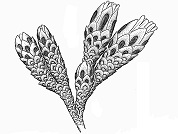Rediscovery and confirmation of the presence of Pycnophyllum macropetalum (Caryophyllaceae) for the Argentinian flora
DOI:
https://doi.org/10.14522/darwiniana.2024.121.1204Keywords:
Argentina, Caryophyllaceae, phylogeny, PycnophyllumAbstract
Pycnophyllum macropetalum Matff. is a species originally described for the Andes of Chile which has also been collected in Bolivia and in Argentina. Presence of P. macropetalum in Argentina is based on a single sterile specimen collected in 1945. For this reason, and because P. macropetalum is morphologically very similar to P. molle, the species was excluded from the Argentinian flora; however, recently, a population of P. macropetalum has been found in the province of Jujuy (Argentina). Therefore, the objective of this work is to describe and to illustrate this species, to provide environmental notes about the habitat where it was found, and to provide a map of the geographic distribution of the species for Argentina, Bolivia and Chile. Furthermore, based on molecular analyzes of the collected specimen, the morphological identification is corroborated, and the monophyly of the genus is confirmed. Finally, a dichotomous key is provided to differentiate the four Pycnophyllum species recorded in Argentina.
References
Bena, M. J.; J. M. Acosta & L. Aagesen. 2017. Macroclimatic niche limits and the evolution of C4 photosynthesis in Gomphrenoideae (Amaranthaceae). Botanical Journal of the Linnean Society 184(3): 283-297. DOI: https://doi.org/10.1093/botlinnean/box031.
Bena, M. J.; T. Ortuño & J. M. Acosta. 2020. Disentangling the Taxonomic Variations within the High-Andean Complex Gomphrena meyeniana (Gomphrenoideae, Amaranthaceae). Systematic Botany 45(2): 294-305. DOI: https://doi.org/10.1600/036364420X15862837791195.
Bittrich, V. 1993. Caryophyllaceae, en K. Kubitzki, J. Rohwer & V. Bittrich (eds.), The Families and Genera of Vascular Plants 2: 206-236. Berlin: Springer-Verlag. https://doi.org/10.1007/978-3-662-02899-5_21.
Cabrera, A. L. 1957. La vegetación de la Puna Argentina. Revista de Investigaciones Agrícolas 11(4): 317-512.
Doyle, J. & J. L. Doyle. 1987. A rapid DNA isolation procedure for small quantities of fresh leaf tissue. Phytochemical Bulletin 19(1):11-15.
Felsenstein, J. 1985. Phylogenies and the comparative method. The American Naturalist 125: 1-15. DOI: https://doi.org/10.1086/284325.
Goloboff, P.; J. Farris & K. C. Nixon. 2008. TNT, a free program for phylogenetic analysis. Cladistics 24: 774-786. DOI: https://doi.org/10.1111/j.1096-0031.2008.00217.x.
Grisebach, A. H. R. 1874. Plantae Lorentzianae. Abhandlungen der Königlichen Gesellschaft der Wissenschaften zu Göttingen. Göttingen 19: 49-279.
Greenberg, A. K. & M. J. Donoghue. 2011. Molecular systematics and character evolution in Caryophyllaceae. Taxon 60: 1637-1652. DOI:https://doi.org/10.1002/tax.606009.
Harbaugh, D. T.; M. Nepokroeff, R. K. Rabeler, J. McNeill, E. A. Zimmer, & W. L. Wagner. 2010. A new lineage-based tribal classification of the family Caryophyllaceae. International Journal of Plant Sciences 171(2): 185-198. DOI: https://doi.org/10.1086/648993.
Hernández-Ledesma, P.; W. G. Berendsohn, T. Borsch, S. von Mering, H. Akhani, S. Arias, L. Castañeda-Noa, U. Eggli, R. Eriksson, H. Flores-Olvera, S. Fuentes-Bazán, G. Kadereit, C. Klak, N. Korotkova, R. Nyffeler, G. Ocampo, H. Ochoterena, B. Oxelman, R. K. Rabeler, A. Sánchez, B. O. Schlumpberger & P. Uotila. 2015. A taxonomic backbone for the global synthesis of species diversity in the angiosperm order Caryophyllales. Willdenowia 45: 281-383. DOI: https://doi.org/10.3372/wi.45.45301
López, V. L.; J. M. Cellini, & G. A. E. Cuyckens. 2021. Influencia del micrositio y el ambiente en la instalación de Polylepis tarapacana en los Altos Andes. Neotropical Biodiversity 7: 135-145. DOI: https://doi.org/10.1080/23766808.2021.1902251
MacBride, J. F. 1937. Caryophyllaceae, en J. F. Macbride (ed.), Flora of Peru. Publications of the Field Museum of Natural History, Botanical Series 13(2): 578-639. DOI: https://doi.org/10.5962/bhl.title.2322
Mattfeld, J. 1922. Revision der Gattung Pycnophyllum Remy. Feddes Repertorium 17: 167-179. DOI: https://doi.org/10.1002/fedr.19220181003
Molinari, E. 2016. Further nomenclatural changes regarding Peruvian endemics. Polish Botanical Journal 61: 275-277. DOI: https://doi.org/10.1515/pbj-2016-0021
Muschler, R. 1911. Caryophyllaceae andinae. Botanische Jahrbucher 45: 441-461.
Pax, F. 1893. Über die Verbreitung der südamerikanischen Caryophyllaeceae und die Arten der Republica Argentina. Botanische Jahrbücher 18: 1-35.
POWO 2023. Plants of the World Online. Pycnophyllum J. Rèmy. Facilitated by the Royal Botanic Gardens, Kew. https://powo.science.kew.org/taxon/urn:lsid:ipni.org:names:30010616-2 [Accessed June 2023].
Ricardi, M. & C. Marticorena. 1961. Plantas interesantes o nuevas para Chile. Gayana Botánica 14: 3-29.
Rohrbach, P. 1870. Beiträge zur Systematik der Caryophyllinen. I. Ueber die Gattung Pycnophyllum. Linnaea 36(6): 651-664.
Stamatakis, A. 2014. RAxML version 8: a tool for phylogenetic analysis and post-analysis of large phylogenies. Bioinformatics 30: 1312-1313. DOI: https://doi.org/10.1093/bioinformatics/btu033.
Stamatakis, A.; P. Hoover & J. Rougemont. 2008. A rapid bootstrap algorithm for the RAxML web servers. Systematic Biology 57(5): 758-771. DOI: https://doi.org/10.1080/10635150802429642.
Timaná, M. E. 2005. Systematic Studies in Pycnophyllum and Pycnophyllopsis (Caryophyllaceae) of the High Andes. Tesis Doctoral. Austin, The University of Texas, School of Biological Sciences, pp. 299.
Timaná, M. E. 2017. Nomenclatural notes on the Andean genera Pycnophyllopsis and Pycnophyllum (Caryophyllaceae). Lundellia 20(1): 4-24. DOI: https://doi.org/10.25224/1097-993X-20.1.4
Zanotti, C. A. 2022. Pycnophyllum, en F. O. Zuloaga & C. A. Zanotti (eds.), Flora Vascular de la República Argentina 19(3): 145-149. Buenos Aires: Estudio Sigma S.R.L.

Downloads
Published
How to Cite
Issue
Section
License

Starting on 2012, Darwiniana Nueva Serie uses Licencia Creative Commons Atribución-NoComercial 2.5 Argentina .





